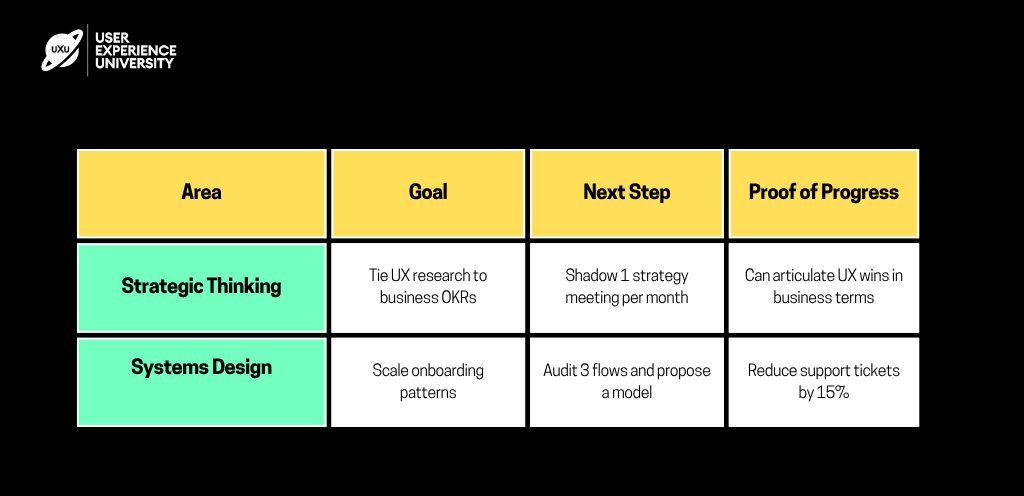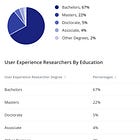5 Steps to Create a Future‑Proof UX Career Ladder
The 5-Step Framework for Crafting Your Own
If the ladder doesn’t exist... build it yourself.
In too many companies, UX career paths are either murky... or missing.
You hit a ceiling. You keep asking, “What’s next?” and getting vague answers like “keep doing great work.”
Or worse, you’re offered a management title with no training, no team, and no clue what the role actually means.
If you don’t define your own growth, someone else will.
This issue is for every UXer who’s ready to stop waiting for career clarity and start building it.
Why Most UX Career Ladders Don’t Work
The 5-Step Framework for Crafting Your Own
What Skills Matter More Than Titles
What to Do If Your Company Doesn’t Support You
UXCON25 Spotlight: Leveling Up Without Burning Out
Resource Corner
Why Most UX Career Ladders Don’t Work
Because they’re built after the fact.
Or borrowed from product and engineering without UX in mind.
What that looks like:
No clear path for senior ICs
Promotions based on years, not impact
Undefined leadership expectations
Confusing overlap between titles (Senior vs. Lead vs. Principal)
You don’t need more rungs.
You need a ladder that reflects the skills, impact, and values unique to your UX role.
The 5-Step Framework for a Future-Proof UX Ladder
1. Define What “Growth” Means to You
Not everyone wants to manage.
Not everyone wants to stay hands-on.
Ask yourself:
Do I want more influence or more craft depth?
Am I energized by coaching and strategy… or pixels and patterns?
What kind of work do I want to be doing in 3 years?
Growth isn’t a direction. It’s a destination.
2. Identify 3–5 Core Competencies You Want to Build
Start with broad skills that translate across roles:
Influence (Can I shift decisions?)
Strategy (Can I connect UX to business?)
Execution (Can I deliver at speed and quality?)
Leadership (Can I inspire and support others?)
Systems Thinking (Can I scale UX, not just deliver it?)
Map these to your current strengths... and the gaps you need to fill.
3. Reverse-Engineer the Job You Want
Find 2–3 people who are already where you want to be.
Look at their:
Portfolios
Talks or interviews
LinkedIn summaries
Projects they’ve led
Ask:
What did they do that I haven’t yet?
What language do they use that I’m not using?
Then plan your next year around closing that gap.
4. Create Your Personal Growth Map
Forget vague OKRs.
Use this simple structure:
Keep it simple, live, and shared with your manager.
5. Share the Plan… Even If No One Asked
Growth isn’t always granted. Sometimes it’s claimed.
Book a 1:1 with your manager and say:
“Here’s what I want to grow into.
Here’s how I plan to do it.
I’d love your support or honest feedback if I’m missing something.”
If your company resists?
You’ve still got a plan to grow and leave, if needed.
⚖️ What Skills Matter More Than Titles
In 2025, companies are shifting from titles to impact.
Here’s what’s quietly becoming non-negotiable:
Presenting UX work in business language
Navigating ambiguity with confidence
Making tradeoffs, not just recommendations
Leading without being the boss
Teaching others your craft
These don’t show up in most job descriptions...
But they’re what make you promotable.
🧭 What to Do If Your Company Doesn’t Support You
You have 3 options:
Start the conversation anyway - some teams just need a nudge.
Create your own path - treat yourself like a product.
Find a company that values UX growth - and has the structure to prove it.
You don’t have to be stuck.
You just have to stop waiting.
🎤 UXCON25 Spotlight: Leveling Up Without Burning Out
At UXCON25, we’re not just talking about job titles.
We’re talking about real career growth and what that actually looks like today.
You’ll hear from:
Senior ICs who built paths without becoming managers
UX leads who created internal ladders from scratch
Career coaches who’ve helped hundreds of UXers break through glass ceilings
🎟️ Grab your UXCON25 ticket
📚 Resource Corner
💡 Final Thought
No one hands you a map. You have to draw it.
Start with what matters to you. Then build your plan. Make it visible. Make it real.
And keep climbing your way.







